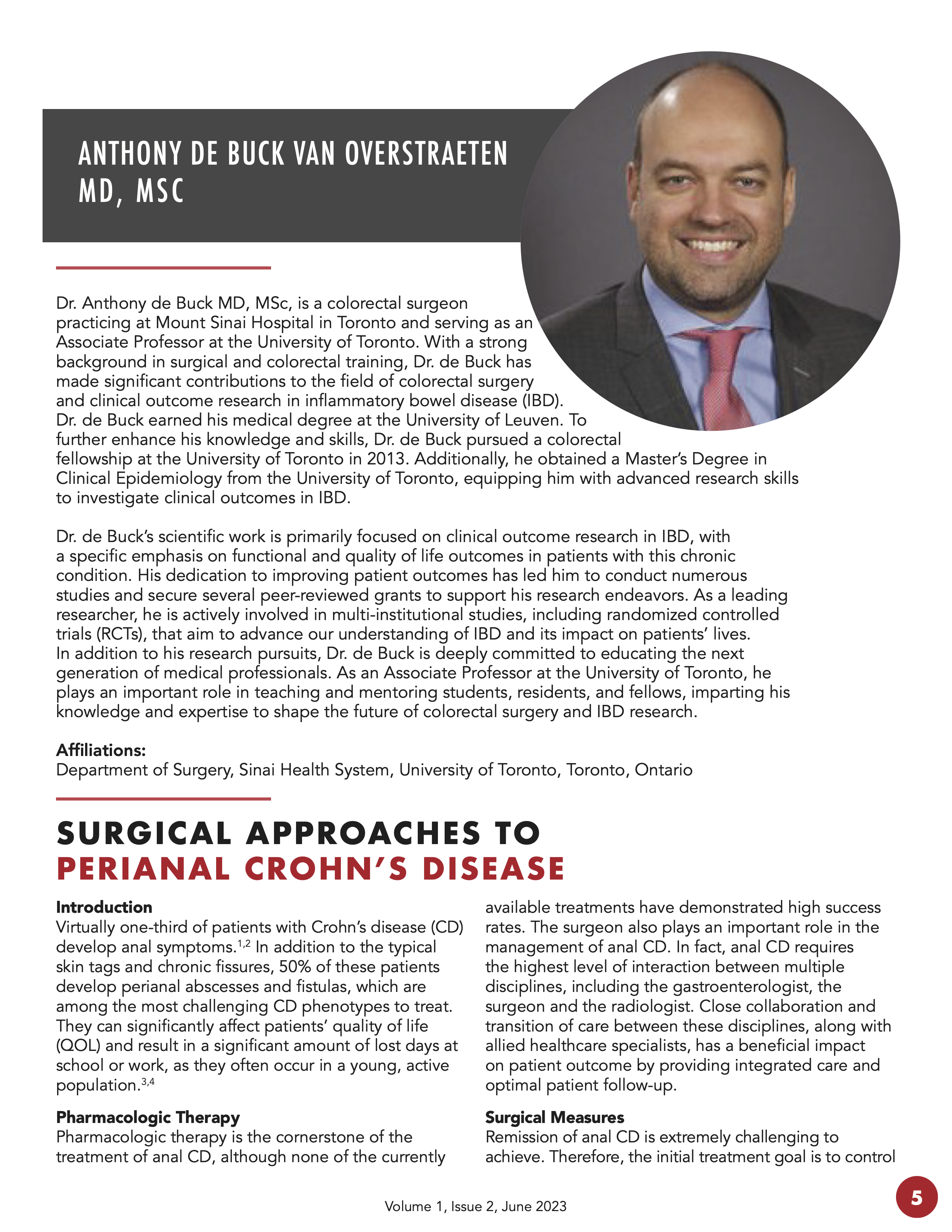Surgical Approaches to Perianal Crohn's Disease
DOI:
https://doi.org/10.58931/cibdt.2023.1211Abstract
Virtually one-third of patients with Crohn’s disease (CD) develop anal symptoms. In addition to the typical skin tags and chronic fissures, 50% of these patients develop perianal abscesses and fistulas, which are among the most challenging CD phenotypes to treat. They can significantly affect patients’ quality of life (QOL) and result in a significant amount of lost days at school or work, as they often occur in a young, active population.
References
Eglinton TW, Barclay ML, Gearry RB, Frizelle FA. The spectrum of perianal Crohn’s disease in a population-based cohort. Dis Colon Rectum. 2012;55(7):773-777. doi:10.1097/DCR.0b013e31825228b0 DOI: https://doi.org/10.1097/DCR.0b013e31825228b0
Wewer MD, Zhao M, Nordholm-Carstensen A, Weimers P, Seidelin JB, Burisch J. The Incidence and Disease Course of Perianal Crohn’s Disease: A Danish Nationwide Cohort Study, 1997-2015. J Crohns Colitis. 2021;15(1):5-13. doi:10.1093/ecco-jcc/jjaa118 DOI: https://doi.org/10.1093/ecco-jcc/jjaa118
Vollebregt PF, van Bodegraven AA, Markus-de Kwaadsteniet TML, van der Horst D, Felt-Bersma RJF. Impacts of perianal disease and faecal incontinence on quality of life and employment in 1092 patients with inflammatory bowel disease. Aliment Pharmacol Ther. 2018;47(9):1253-1260. doi:10.1111/apt.14599 DOI: https://doi.org/10.1111/apt.14599
Lönnfors S, Vermeire S, Greco M, Hommes D, Bell C, Avedano L. IBD and health-related quality of life -- discovering the true impact. J Crohns Colitis. 2014;8(10):1281-1286. doi:10.1016/j.crohns.2014.03.005 DOI: https://doi.org/10.1016/j.crohns.2014.03.005
Meima-van Praag EM, van Rijn KL, Wasmann KATGM, et al. Short-term anti-TNF therapy with surgical closure versus anti-TNF therapy in the treatment of perianal fistulas in Crohn’s disease (PISA-II): a patient preference randomised trial. Lancet Gastroenterol Hepatol. 2022;7(7):617-626. doi:10.1016/S2468-1253(22)00088-7 DOI: https://doi.org/10.1016/S2468-1253(22)00088-7
Park MY, Yoon YS, Kim HE, et al. Surgical options for perianal fistula in patients with Crohn’s disease: A comparison of seton placement, fistulotomy, and stem cell therapy. Asian J Surg. 2021;44(11):1383-1388. doi:10.1016/j.asjsur.2021.03.013 DOI: https://doi.org/10.1016/j.asjsur.2021.03.013
Stellingwerf ME, van Praag EM, Tozer PJ, Bemelman WA, Buskens CJ. Systematic review and meta-analysis of endorectal advancement flap and ligation of the intersphincteric fistula tract for cryptoglandular and Crohn's high perianal fistulas. BJS Open. 2019 Jan 21;3(3):231-241. doi:10.1002/bjs5.50129 DOI: https://doi.org/10.1002/bjs5.50129
van Praag EM, Stellingwerf ME, van der Bilt JDW, Bemelman WA, Gecse KB, Buskens CJ. Ligation of the Intersphincteric Fistula Tract and Endorectal Advancement Flap for High Perianal Fistulas in Crohn's Disease: A Retrospective Cohort Study. J Crohns Colitis. 2020 Jul 9;14(6):757-763. doi:10.1093/ecco-jcc/jjz181 DOI: https://doi.org/10.1093/ecco-jcc/jjz181
Rojanasakul A, Pattanaarun J, Sahakitrungruang C, Tantiphlachiva K. Total anal sphincter saving technique for fistula-in-ano; the ligation of intersphincteric fistula tract. J Med Assoc Thai. 2007;90(3):581-586.
Kamiński JP, Zaghiyan K, Fleshner P. Increasing experience of ligation of the intersphincteric fistula tract for patients with Crohn’s disease: what have we learned? Colorectal Dis Off J Assoc Coloproctology. 2017;19(8):750-755. doi:10.1111/codi.13668 DOI: https://doi.org/10.1111/codi.13668
Gingold DS, Murrell ZA, Fleshner PR. A prospective evaluation of the ligation of the intersphincteric tract procedure for complex anal fistula in patients with Crohn’s disease. Ann Surg. 2014;260(6):1057-1061. doi:10.1097/SLA.0000000000000479 DOI: https://doi.org/10.1097/SLA.0000000000000479
Safar B, Jobanputra S, Sands D, Weiss EG, Nogueras JJ, Wexner SD. Anal fistula plug: initial experience and outcomes. Dis Colon Rectum. 2009;52(2):248-252. doi:10.1007/DCR.0b013e31819c96ac DOI: https://doi.org/10.1007/DCR.0b013e31819c96ac
Senéjoux A, Siproudhis L, Abramowitz L, et al. Fistula Plug in Fistulising Ano-Perineal Crohn’s Disease: a Randomised Controlled Trial. J Crohns Colitis. 2016;10(2):141-148. doi:10.1093/ecco-jcc/jjv162 DOI: https://doi.org/10.1093/ecco-jcc/jjv162
Christoforidis D. Who benefits from the anal fistula plug? Dis Colon Rectum. 2010;53(8):1105-1106. doi:10.1007/DCR.0b013e3181e27efb DOI: https://doi.org/10.1007/DCR.0b013e3181e27efb
Meinero P, Mori L. Video-assisted anal fistula treatment (VAAFT): a novel sphincter-saving procedure for treating complex anal fistulas. Tech Coloproctology. 2011;15(4):417-422. doi:10.1007/s10151-011-0769-2 DOI: https://doi.org/10.1007/s10151-011-0769-2
Wilhelm A. A new technique for sphincter-preserving anal fistula repair using a novel radial emitting laser probe. Tech Coloproctology. 2011;15(4):445-449. doi:10.1007/s10151-011-0726-0 DOI: https://doi.org/10.1007/s10151-011-0726-0
García-Olmo D, García-Arranz M, García LG, et al. Autologous stem cell transplantation for treatment of rectovaginal fistula in perianal Crohn’s disease: a new cell-based therapy. Int J Colorectal Dis. 2003;18(5):451-454. doi:10.1007/s00384-003-0490-3 DOI: https://doi.org/10.1007/s00384-003-0490-3
Panés J, García-Olmo D, Van Assche G, et al. Expanded allogeneic adipose-derived mesenchymal stem cells (Cx601) for complex perianal fistulas in Crohn’s disease: a phase 3 randomised, double-blind controlled trial. Lancet. 2016;388(10051):1281-1290. doi:10.1016/S0140-6736(16)31203-X DOI: https://doi.org/10.1016/S0140-6736(16)31203-X
Abdalla MI, Sandler RS, Kappelman MD, et al. The Impact of Ostomy on Quality of Life and Functional Status of Crohn’s Disease Patients. Inflamm Bowel Dis. 2016;22(11):2658-2664. doi:10.1097/MIB.0000000000000930 DOI: https://doi.org/10.1097/MIB.0000000000000930

Published
How to Cite
Issue
Section
License
Copyright (c) 2023 Canadian IBD Today

This work is licensed under a Creative Commons Attribution-NonCommercial-NoDerivatives 4.0 International License.
